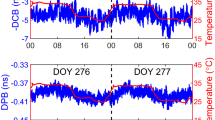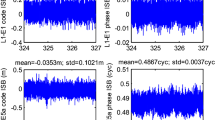Abstract
A receiver hardware delay should be seriously considered for time-transfer and determination of ionospheric delay corrections for wide area differential GPS positioning. A receiver hardware delay does not generally effect the common geo-position application, as suitable differences of observations are used, or equivalently, clock error parameters are introduced, epoch-wise, that also absorb the delays. This paper investigates the behavior of inter-frequency (or observation-type) receiver hardware delays by using a single difference (SD) model, which estimates the receiver delay along with the receiver clock error (and SD ambiguities of a reference satellite with carrier phase observations) for zero and short baselines. The purpose of this paper is to model the between-observation-type delays for the purpose of precise positioning, under practical circumstances. The focus is on data series of differential SD receiver clock biases, since they reflect the behavior of receiver hardware delays with time. A simple linear regression of the data series is employed to study the behavior, and test statistics are employed to assess both the significance of the parameters and the observations’ fit for the linear regression. The statistical analysis results indicate that almost all inter-observation type receiver delays can be modeled as the sum of a constant (offset) and a constant rate of change (slope). The analysis shows that the differential receiver delay is generally at the mm- to cm-level on phase, while at the dm-level on code for the equipment used in the experiments.














Similar content being viewed by others
References
Baarda W (1973) S-transformations and criterion matrices. Netherlands Geodetic Commission. Publications on Geodesy. New Series vol 5, no 1, Delft
Dach R, Beutler G, Hugentobler U, Schaer S, Schildknecht T, Springer T, Dudle G, Prost L (2003) Time transfer using GPS carrier phase: error propagation and results. J Geodesy 77:1–14
de Jong CD (1999) Quality control and precise kinematic GPS positioning – theory and applications. Presented at Shallow Survey 99, Sydney, Australia, Oct. 18–20, 1999, 18 pp
Gao Y, Heroux P, Kouba J (1994): Estimation of GPS receiver and satellite L1/L2 signal delay biases using data from CACS. Proceedings of International Symposium on Kinematic Systems in Geodesy, Geomatics and Navigation, Banff, Alberta, Canada, August 20–September 2, 1994, pp 109–116
Gao Y, Heroux P, Liao X, Lahaye F, Beck N, Olynik M (1999) GPS instrumental bias between receivers. Proceedings ION 55th Annual Meeting, 28–30 June 1999, Cambridge, MA, pp 209–216
Gao Y, Lahaye F, Heroux P, Liao X, Beck N, Olynik M (2001) Modeling and estimation of C1-P1 bias in GPS receivers. J Geodesy 74:621–626
Gurtner W (1994) RINEX: Receiver Independent Exchange format. GPS World 5(6):48–52
Koch K-R (1999) Parameter estimation and hypothesis testing in linear models, 2nd edn. Springer, Berlin Heidelberg New York
Larson KM, Levine J (1999) Carrier-phase time transfer, IEEE Transactions on Ultrasonics, Ferroelectrics, and Frequency Control, vol 46, no 4, July 1999, pp 1001–1012
Ray J, Senior K (2002) New IGS clock products: a global time transfer assessment, GPS World, vol 13, no 11, November 2002, pp 45–51
Teunissen PJG (2002) Testing theory: an introduction. Series on Mathematical Geodesy and Positioning, Delft University Press, Delft, The Netherlands, 2002
Tiberius CCJM (1999) The GPS data weight matrix: what are the issues? Proceedings of National Technical Meetings & 19th Biannual Guidance Test Symposium of ION 1999, pp 219–227, January 25–27, 1999, San Diego, CA, USA, pp 219–227
Wilson BD, Mannucci AJ (1993) Instrumental biases in ionospheric measurements derived from GPS data. Proceedings of ION GPS-93, Salt Lake City, UT, September 22–24, 1993, pp 1343–1351
Acknowledgements
The first author was supported by the DELTA (Dutch Education: Learning at Top-level Abroad) scholarship from NUFFIC (Netherlands organization for international cooperation in higher education) of the Netherlands. Valuable and helpful comments were made by Dr. Jim Ray and an anonymous reviewer. Their contributions are highly appreciated.
Author information
Authors and Affiliations
Corresponding author
Rights and permissions
About this article
Cite this article
Liu, X., Tiberius, C. & de Jong, K. Modelling of differential single difference receiver clock bias for precise positioning. GPS Solutions 7, 209–221 (2004). https://doi.org/10.1007/s10291-003-0079-x
Received:
Accepted:
Published:
Issue Date:
DOI: https://doi.org/10.1007/s10291-003-0079-x




